Configure declarative schema
Before Magento 2.3, extension developers were required to write code (PHP scripts) to change the database schema. The following types of scripts existed before Magento 2.3:
- InstallData and InstallSchema scripts, which are executed on a clean (empty) database
- UpgradeData and UpgradeSchema incremental scripts, which supplement an existing Magento database
- Recurring scripts, which are executed each time you install or upgrade Magento
Each script iteratively adds changes. During the installation process, Magento applies only those changes that have not been applied yet. For example, if you have Magento 2.1.8 installed and the latest version is 2.1.11, then the upgrade scripts for 2.1.9, 2.1.10, and 2.1.11 will be applied, in order, when you upgrade to 2.1.11. That procedure is called migration setup or migration scripts.
The main disadvantage of this approach is that Magento applies changes blindly. For example, in one version a new database column might be introduced, only to be removed in the next. Declarative setup eliminates this type of unnecessary work.
Declarative setup is based on database structure declarations, and is used in projects such as Doctrine. Schema files declare what the database structure should be, and Magento determines the differences between the current table structure and what it should be. These differences can be represented with atomic SQL operations.
The following example, extracted from the Catalog/etc/db_schema.xml file, defines the catalog_product_entity_datetime table:
<table name="catalog_product_entity_datetime" resource="default" engine="innodb"
comment="Catalog Product Datetime Attribute Backend Table">
<column xsi:type="int" name="value_id" padding="11" unsigned="false" nullable="false" identity="true" comment="Value ID"/>
<column xsi:type="smallint" name="attribute_id" padding="5" unsigned="true" nullable="false" identity="false"default="0" comment="Attribute ID"/>
<column xsi:type="smallint" name="store_id" padding="5" unsigned="true" nullable="false" identity="false" default="0" comment="Store ID"/>
<column xsi:type="int" name="entity_id" padding="10" unsigned="true" nullable="false" identity="false" default="0"/>
<column xsi:type="datetime" name="value" on_update="false" nullable="true" comment="Value"/>
<constraint xsi:type="primary" name="PRIMARY">
<column name="value_id"/>
</constraint>
</table>
db_schema structure
The <Module_Vendor>/<Module_Name>/etc/db_schema.xml file declares a module’s database structure.
If you have enabled URN highlighting, you can use the PHPStorm autocomplete feature after choosing a node’s xsi:type. This will also allow you to view which attributes are available on each line of your db_schema.xml file
Top-level node
The schema node defines the location of the schema.xsd file.
<schema xmlns:xsi="http://www.w3.org/2001/XMLSchema-instance"
xsi:noNamespaceSchemaLocation="urn:magento:setup:Model/Declaration/Schema/etc/schema.xsd">
table node
Each db_schema.xml file should contain one or more table nodes. Each table node represents a table in the database.
A table node can contain the following attributes:
| Attribute | Description |
|---|---|
name |
The name of the table. |
engine |
SQL engine. This value must be innodb or memory. |
resource |
The database shard on which to install the table. This value must be default, quote, or sales. |
comment |
Table comment. |
A table node can contain three types of subnodes:
columnconstraintindex
column subnode
The column subnode defines a column in a table. Each column requires its own declaration.
A column can have the following attributes:
| Attribute | Description |
|---|---|
xsi:type |
Specifies the column type. Must be one of the following:
|
default |
Initializes the column with the specified default value. The default value should have the same datatype defined in xsi:type.
|
disabled |
Disables or deletes the declared table, column, constraint, or index. |
identity |
Indicates whether a column is auto incremented. |
length |
In text and binary types (including varchar and varbinary), specifies the length of a column. |
nullable |
Indicates whether column can be nullable. |
onCreate |
This is a DDL trigger that allows you to move data from an existing column to a newly created column. This trigger works only when a column is created. |
padding |
The size of an integer column. |
precision |
The number of allowed digits in a real data type. |
scale |
The number of digits after the decimal in a real data type. |
unsigned |
For numeric data types, specifies whether the column can contain positive and negative values or only positive values. |
For more information about each type, refer to the annotations in the corresponding XSD file. The XSD files are located in the <Magento_root_directory/setup/src/Magento/Setup/Model/Declaration/Schema/etc directory.
Example:
<column xsi:type="int" name="entity_id" padding="10" unsigned="true" nullable="false" identity="true" comment="Credit ID"/>
constraint subnode
The constraint subnode is represented by 3 different types:
primaryuniqueforeign
The primary and unique constraints are called “internal” constraints, because they can be applied only to the scope of the table where they are created. Internal constraints define the name attribute and contain one or more column subnodes. Each subnode defines a constrained column.
The following example shows the format of an internal constraint.
<constraint xsi:type="primary" name="PRIMARY">
<column name="entity_id"/>
</constraint>
The foreign constraint is similar to foreign keys in SQL. This type of constraint connects two tables with each other. The following attributes define a foreign constraint:
| Attribute | Description |
|---|---|
column |
A column in the current table that refers to a specific column in another table. |
referenceTable |
The table being referenced. |
referenceColumn |
A column in the referenceTable. |
onDelete |
Foreign key trigger. The value must be CASCADE, SET NULL, or NO ACTION. |
Example:
<constraint xsi:type="foreign" name="COMPANY_CREDIT_COMPANY_ID_DIRECTORY_COUNTRY_COUNTRY_ID" table="company_credit" column="company_id" referenceTable="company" referenceColumn="entity_id" onDelete="CASCADE"/>
index subnode
The index subnode has the same structure as internal constraints but contains different logic. While constraints are used for defining limitations, indexes are used for speeding up DQL operations.
Perform common database operations
This section shows how to perform common database operations using declarative schema. The screen captures use git diff to illustrate how to perform these tasks.
Create a table
The following example creates the table_name table with five columns. The id column is the primary key.

Drop a table
In the following example, the table_name table was completely removed from the db-schema.xml file. To drop a table declared in another module, redeclare it with the disabled attribute set to true.

Rename a table
Table renaming is not supported. However, you can remove an unneeded table declaration and add a new one. Data will be persisted in a CSV dump, but the data will not be added to the new table automatically. You can add the data manually by using data/recurring patches.
Create a foreign key
In the following example, the selected constraint node defines the characteristics of the FL_ALLOWED_SEVERITIES foreign key.
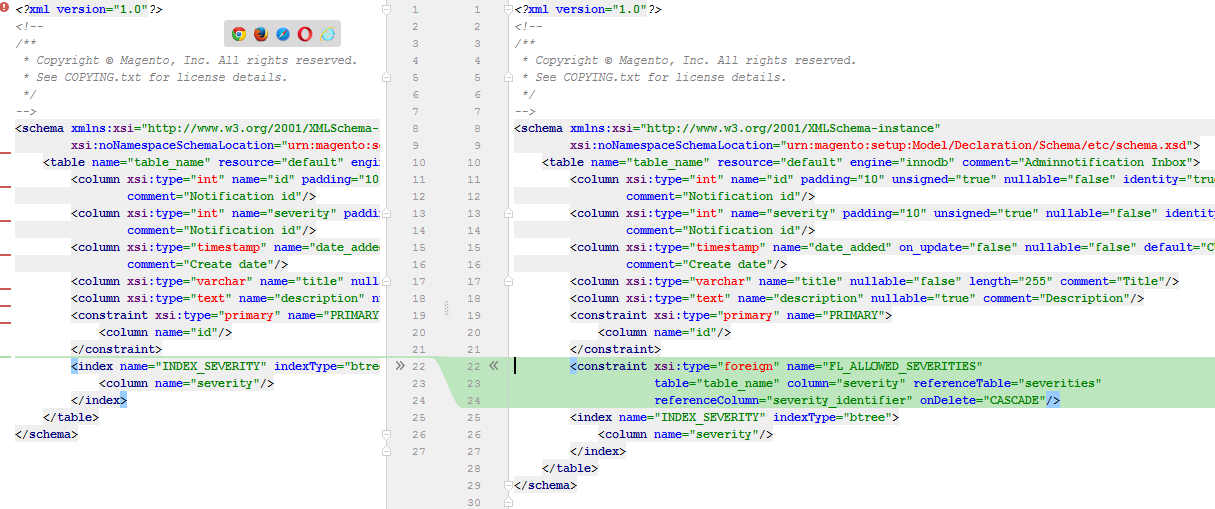
Drop a foreign key
The following example removes the FL_ALLOWED_SEVERITIES foreign key by deleting its constraint node. To drop a constraint declared in another module, redeclare it with the disabled attribute set to true.
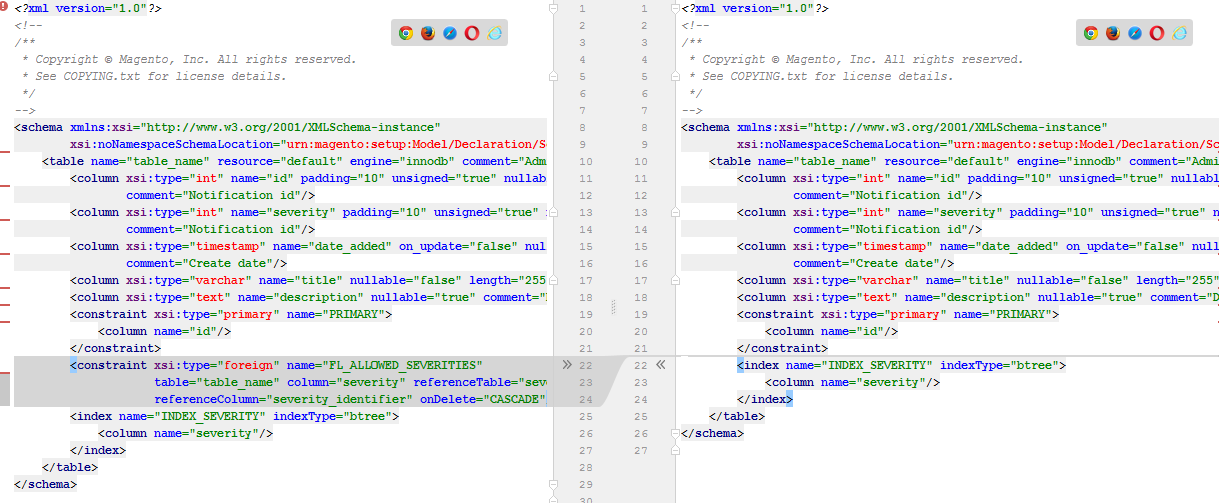
Add a column to table
The following example adds the date_closed column.
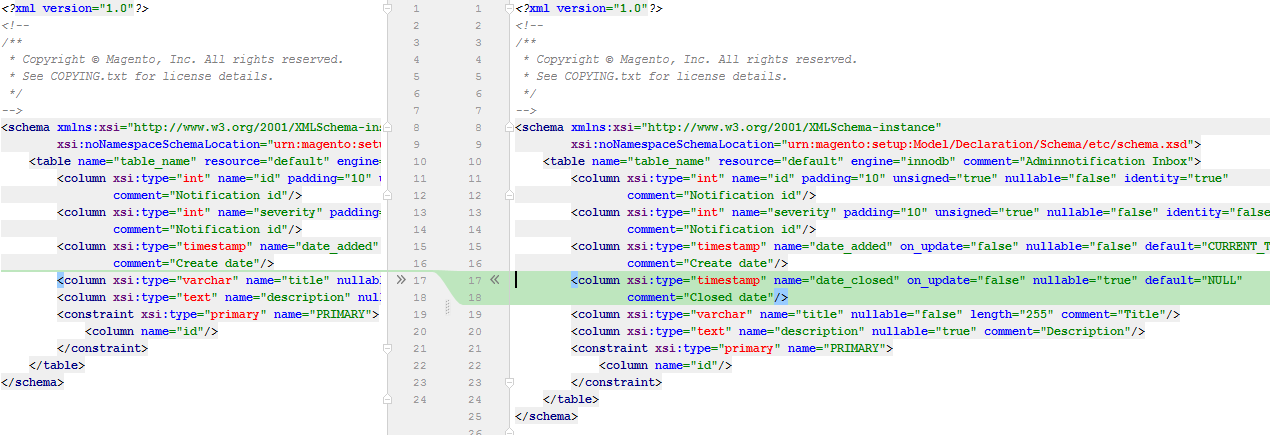
Drop a column from a table
The following example removes the date_closed column by deleting its column node. To drop a column declared in another module, redeclare it with the disabled attribute set to true.
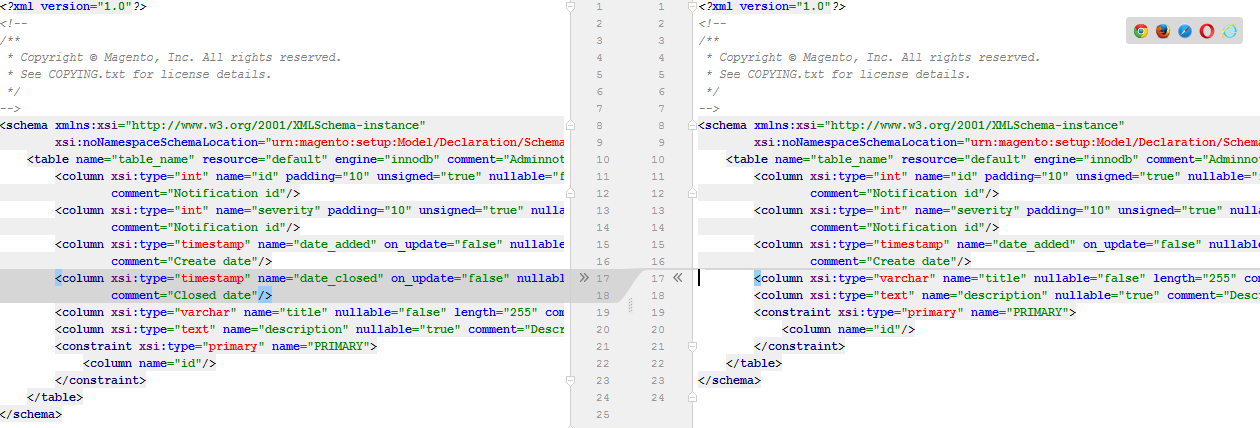
Change the column type
The following example changes the type of the title column from varchar to tinytext.

Rename a column
To rename a column, delete the original column declaration and create a new one. In the new declaration, use the onCreate attribute to specify which column to migrate data from. Use the following construction to migrate data from the same table.
onCreate="migrateDataFrom(entity_id)"
To migrate data from another table, specify a value similar to the following:
onCreate="migrateDataFromAnotherTable(catalog_category_entity,entity_id)"
Add an index
The following example adds the INDEX_SEVERITY index to the table_name table.
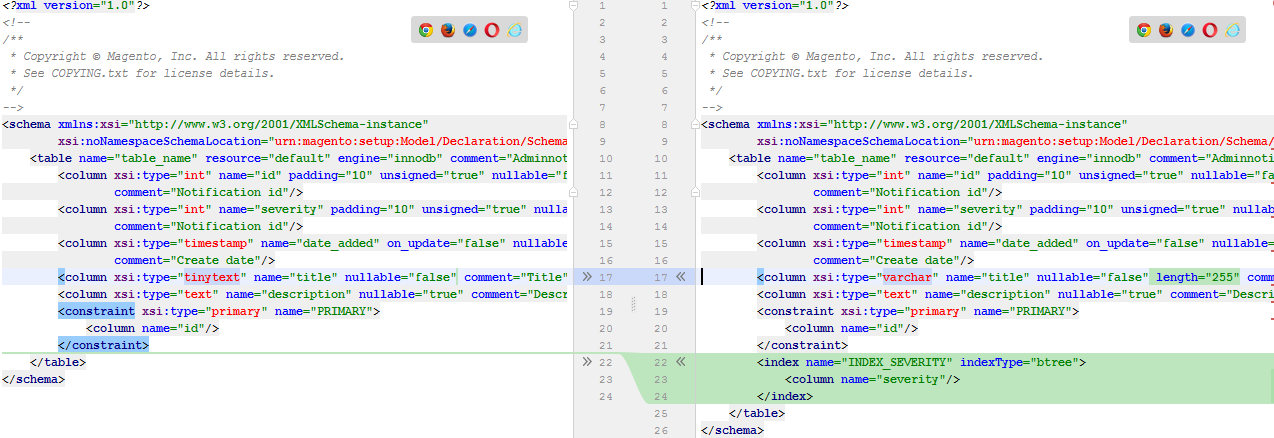
Other tasks
Disable a module
When a module is disabled from the Admin console, its database schema configuration is no longer read on upgrade or install. As a result, subsequent system upgrades rebuild the database schema without the module’s tables, columns, or other elements.